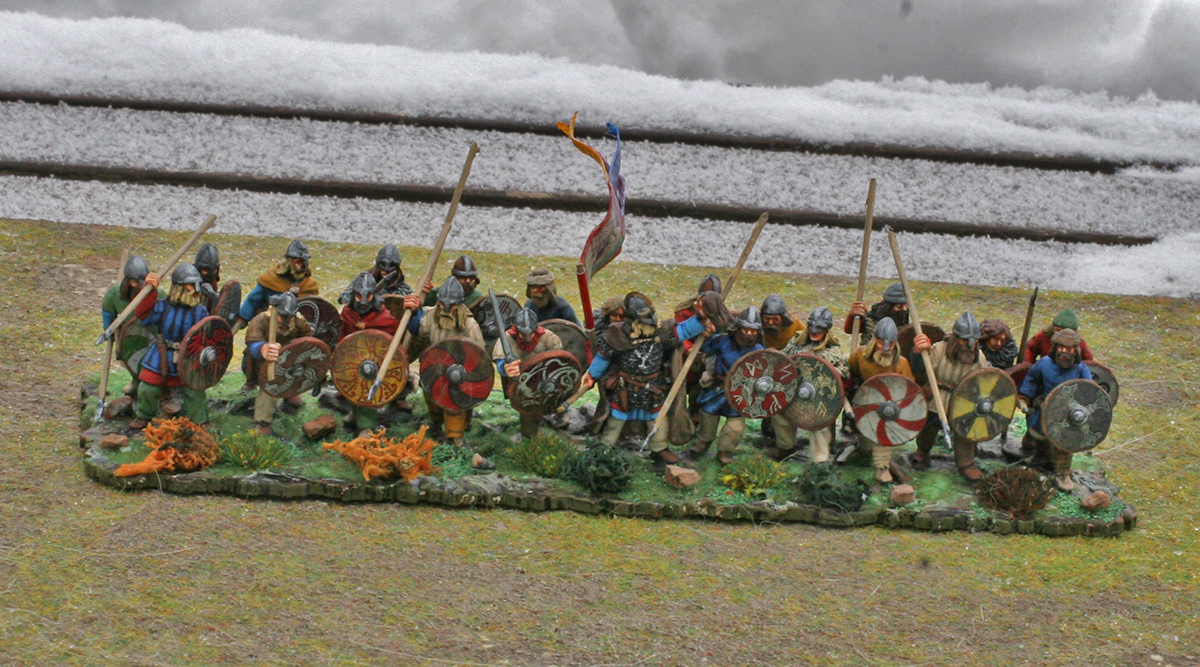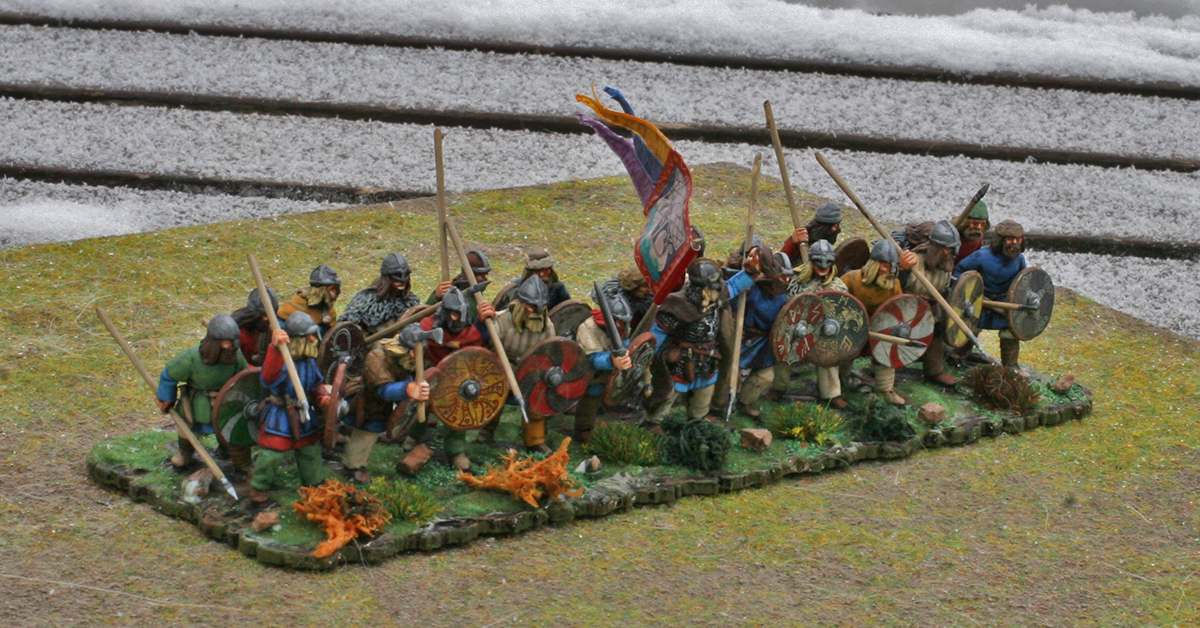- This topic has 24 replies, 11 voices, and was last updated 5 years, 1 month ago by
 Guy Farrish.
Guy Farrish.
-
AuthorPosts
-
06/02/2019 at 13:19 #108647
Truls Engebakken-Fjell
Participant


 06/02/2019 at 13:25 #108648
06/02/2019 at 13:25 #108648 willzParticipant
willzParticipantAn excellent display of Nordic Warriors.
Willz.
06/02/2019 at 13:39 #108649 RuarighParticipant
RuarighParticipantYou can never have too many Vikings, and those look great. I particularly like your use of colour. The Vikings liked colour and would have been a lot more colourful than the hipsters in horse-skin on that TV series.
Never argue with an idiot. They'll only drag you down to their level and beat you with experience.
07/02/2019 at 02:59 #108677 Private SnafuParticipant
Private SnafuParticipantNice work. If I may suggest the orange lichen isn’t working. Top notch otherwise.
___________________
http://moveshootassault.blogspot.com
https://sites.google.com/site/miniaturemachinations07/02/2019 at 10:41 #108706Truls Engebakken-Fjell
ParticipantYou can never have too many Vikings, and those look great. I particularly like your use of colour. The Vikings liked colour and would have been a lot more colourful than the hipsters in horse-skin on that TV series.
I can’t think of a single period in history where people didn’t like colours. Bronze age, classical period, the whole of the medieval period and all of early modern and modern period. The closest you get is late Victorian period and first 60 years of the 19th century. A lot of grey and black(particularly men’s fashion.
Then came the hippie revolution and more colours came back. But even today there’s probably more, blacks, browns, and greys then in much of rest of history.
Orange lichen noted!
07/02/2019 at 12:23 #108709Deleted User
MemberI can’t think of a single period in history where people didn’t like colours.
Didn’t the Beige Age followed the Bronze Age?
Love your Danes BTW.
07/02/2019 at 14:57 #108713Gone Fishing
ParticipantRight, had to sign back in for this one.
TEF, I think the orange lichen is a splendid touch. Your call, of course, but I think it really pops the figures; and you’re right, chances are the Vikings would have liked it themselves!
07/02/2019 at 20:01 #108729 Private SnafuParticipant
Private SnafuParticipantThe availability and cost of various fabrics and dyes is the issue, not whether people liked color.
___________________
http://moveshootassault.blogspot.com
https://sites.google.com/site/miniaturemachinations07/02/2019 at 20:50 #108732Deleted User
MemberOn a side note, a rather rude observer once labelled my Iron Age Celts, “licorice all-sorts” because of their loud coloured clothing.
The cheek!
donald
07/02/2019 at 21:28 #108733 RuarighParticipant
RuarighParticipantThe availability and cost of various fabrics and dyes is the issue, not whether people liked color.
A range of natural dyes was readily available and could be gathered easily in Scandinavia. These dyes would give a wide range of colours, the shade of which could be varied depending upon the mordant used. Many of these dyes are naturally colourfast too, although yellows are typically not so. This picture shows you what can be achieved using only dyestuffs from Scandinavia that were available in the Viking Age.
In terms of cost, we are looking at a predominantly self-sufficient rural society. Nothing would be bought off the peg. People farmed sheep from which they got their wool, and grew flax from which they would make linen. Only the wealthy would have anything else, such as silk or imported dyes, and even though linen took more effort to produce everyone had linen clothes because they were harder wearing than wool. Just as men would have to spend every spare moment chopping wood to ensure they had enough to get through the winter, women would spend every spare moment in textiles production. From plucking the sheep to having a finished set of clothes, it would take about 800 hours, and you would have to pluck, spin and weave about 3.5kg of wool for one set of clothes. Compared to the total production time, gathering dyestuffs and dyeing the clothes takes virtually no time at all. You cannot discount the effect that the importance of status had on people’s approach to this either.
Never argue with an idiot. They'll only drag you down to their level and beat you with experience.
22/02/2019 at 07:01 #109651 Dexey ClarkParticipant
Dexey ClarkParticipantThroughout history the average bod could not afford ‘colours’, perhaps?
Interesting referenced article here: http://1000footgeneral.blogspot.com/2012/09/dark-ages-color-palettes.html
22/02/2019 at 10:02 #109656 RuarighParticipant
RuarighParticipantThroughout history the average bod could not afford ‘colours’, perhaps?
The ordinary people did not buy dyestuffs, they gathered them. They also farmed the materials they needed to make the clothes. The only cost is a time investment. Women would have been involved in textiles production in every spare moment to ensure that there was enough cloth to go around. The collecting of dyestuffs and the time spent dyeing is a tiny percentage of that time investment. Most average people would have been willing to make that investment because status was important, and coloured cloth was one way of putting on a show to maintain your status.
Never argue with an idiot. They'll only drag you down to their level and beat you with experience.
22/02/2019 at 14:28 #109675 Dexey ClarkParticipant
Dexey ClarkParticipantIs there evidence for that?
Status is a relative thing and not necessarily assigned by an individual to themselves. The wider clan, extended family and overlords are more likely to award status and allow, or disallow, any changes to an individuals I would have thought.
22/02/2019 at 15:53 #109679 Guy FarrishParticipant
Guy FarrishParticipantEarly medieval period…? Not sure if there is any evidence for regulation of status through dress code per se.
Sumptuary laws are introduced pretty much across Europe in the early 14th century – 1336 for England, 1345 Sweden. This may simply reflect a growing state/royal codification of local or customary laws/regulations or may reflect an attempt to stamp authority on a populace that wasn’t showing sufficient deference through dress (maybe the king wasn’t the only one not covered in s**t after all?).
Sumptuary law is tied in with class and particularly gender differentiation and control. How much this was a facet of early medieval life I leave to experts like Ruarigh but the supposed reasons for its codification or introduction in the late 13th early 14th centuries revolve around the growing opportunities to differentiate with increased availability of materials like silks which were to be confined to aristocratic or rich merchant classes. How much agrarian and pastoral societies like the Norse would have controlled and awarded status through clothing and colour is not clear to me.
The fact emergent 14th century states felt the need to codify such things suggests that there was possibly not that much control in practice regardless of theory prior to that.
22/02/2019 at 16:26 #109681 Not Connard SageParticipant
Not Connard SageParticipantOn a side note, a rather rude observer once labelled my Iron Age Celts, “licorice all-sorts” because of their loud coloured clothing. The cheek! donald
Don’t you mean ‘The check’?
🙂
Obvious contrarian and passive aggressive old prat, who is taken far too seriously by some and not seriously enough by others.
22/02/2019 at 18:16 #109684 RuarighParticipant
RuarighParticipantIs there evidence for that? Status is a relative thing and not necessarily assigned by an individual to themselves. The wider clan, extended family and overlords are more likely to award status and allow, or disallow, any changes to an individuals I would have thought.
There is no evidence for sumptuary laws, but plenty of evidence that the performance of social status was important. It’s not about seeking to gain status by ‘dressing for the job you want’ but rather about maintaining one’s existing social status by dressing and acting appropriately. If you did not do that, or if you overstepped the bounds, people would respond in a negative manner which could have far-reaching consequences.
We also know that the Vikings were fashionistas, and that (according to Alcuin, at least) others followed where they led, cutting their hair in the Viking fashion, etc. Analysis of Early Iron Age textiles from Danish bogs shows various colours in use and that yellow was the most common colour, usually with blue or red accents. Textiles from the Viking Age (Late Iron Age) are generally less well preserved and most of those from higher status graves, but Penelope Walton has a readily available paper on the wool and dyes from Viking Norway and Denmark that is not solely focused on the high-status material. For Viking Age England, this catalogue may be of interest because it references York and the middle ranks of society rather than the top. It lists dyestuffs rather than colour, but you can extrapolate the type of colour from that. ScienceNordic had an article on the Vikings and their fashions based on an interview with Ulla Mannering of the Centre for Textile Research in Copenhagen. If you read Danish or are willing to work with Google translate, it is worth following the link to the Danish version of that article because it has more detail and links to the researchers mentioned. Another researcher whose work on textiles might be useful in this regard is Marianne Vedeler, although I am only familiar with her work on the Oseberg textiles which are high status. All of these sources show the importance of colour, and, again, it is worth remembering that many of the dyestuffs used were readily available and easily gathered, and that the evidence points to the use of local dyestuffs over imported ones, so there are geographical variations in the most common colours. Basically, the evidence stacks up to point to the general use of colour by all the free classes. The difference in status would be less evident in the colours worn than in the quality of the garments, the material used, and the jewellery worn.
Never argue with an idiot. They'll only drag you down to their level and beat you with experience.
22/02/2019 at 18:44 #109685 Dexey ClarkParticipant
Dexey ClarkParticipantThanks. Some excellent information there including the work going on in the 5 Boroughs from the Nottingham site.
22/02/2019 at 19:32 #109688 RuarighParticipant
RuarighParticipantI’m always happy to witter on about Vikings.
We’re working on expanding our East Midlands Vikings site so it will be worth checking back in a month or so once we have a bunch more material up there.
Never argue with an idiot. They'll only drag you down to their level and beat you with experience.
22/02/2019 at 19:53 #109690 Dexey ClarkParticipant
Dexey ClarkParticipantI’ve bookmarked it.
If I weren’t so old I’d go back to studying again :0)
23/02/2019 at 09:38 #109713 RuarighParticipant
RuarighParticipantYou’re never too old to go back to studying.

Never argue with an idiot. They'll only drag you down to their level and beat you with experience.
23/02/2019 at 11:33 #109729 Dexey ClarkParticipant
Dexey ClarkParticipantWhen you are as old as me you may find differently!
I read Guy Halsall’s ‘Warfare and Society in the Barbarian West, 450 – 900 while making notes a couple of weeks ago. I’d have done it in a couple of evenings 40 years back. It took me a lot longer than that!
25/02/2019 at 20:14 #109859Truls Engebakken-Fjell
ParticipantVery cool my Vikings sparked some interesting discussion.
25/02/2019 at 20:24 #109863 Thaddeus BlanchetteParticipant
Thaddeus BlanchetteParticipantIf favela kids can get their hands on Nikes (even counterfeit ones) in today’s Rio de Janeiro, I’m sure medieval peasants could scavenge up the odd bit of flash.
Putting on my social scientists hat here, poor people tend to invest in what’s achievable and clothing is a great investment for them. It is relatively inxpensive and it highlughts their body, which is often the only capital they have.
So I think you can argue quite convincingly that some poor freeman viking warrior, without a pot to piss in, would go off to war looking as flashy as he could, the better to catch his comrades’ eyes when he dos some feat of daring.
We get slapped around, but we have a good time!
26/02/2019 at 10:36 #109946OB
ParticipantThose Vikings look very fine Truls. I have a load of them most unpainted because I couldn’t get them right. I think I’ll copy your colour scheme.
In societies where fines for transgressions ascended up the social scale a bit of colour coding would be a useful thing. Insult a fellow farmer and you can probably weather the damage of the fine. Do it to someone with a higher status and you pay more, perhaps more than you can comfortably afford. Early Irish society was coded by the number of colours a person could wear more colours meant more wealth and status and a higher insult price. It was also highly litigious and kept a whole class of lawyers in comfort.
OB
http://withob.blogspot.co.uk/26/02/2019 at 12:29 #109949 Guy FarrishParticipant
Guy FarrishParticipantYes Truls, they are lovely.
My apologies for getting so wrapped up in the whole colour/drab early medieval period discussion I forget the main point of this – lovely painted figures – thanks for posting.
(Interesting discussion as well).
-
AuthorPosts
- You must be logged in to reply to this topic.


